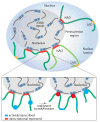The Ribosomal Gene Loci-The Power behind the Throne
- PMID: 34069807
- PMCID: PMC8157237
- DOI: 10.3390/genes12050763
The Ribosomal Gene Loci-The Power behind the Throne
Abstract
Nucleoli form around actively transcribed ribosomal RNA (rRNA) genes (rDNA), and the morphology and location of nucleolus-associated genomic domains (NADs) are linked to the RNA Polymerase I (Pol I) transcription status. The number of rDNA repeats (and the proportion of actively transcribed rRNA genes) is variable between cell types, individuals and disease state. Substantial changes in nucleolar morphology and size accompanied by concomitant changes in the Pol I transcription rate have long been documented during normal cell cycle progression, development and malignant transformation. This demonstrates how dynamic the nucleolar structure can be. Here, we will discuss how the structure of the rDNA loci, the nucleolus and the rate of Pol I transcription are important for dynamic regulation of global gene expression and genome stability, e.g., through the modulation of long-range genomic interactions with the suppressive NAD environment. These observations support an emerging paradigm whereby the rDNA repeats and the nucleolus play a key regulatory role in cellular homeostasis during normal development as well as disease, independent of their role in determining ribosome capacity and cellular growth rates.
Keywords: RNA polymerase I; cancer; cell fate; differentiation; genome architecture; heterochromatin; nucleolar associated domain (NAD); nucleolus; ribosomal genes; transcription.
Conflict of interest statement
The authors declare no conflict of interest.
Figures


References
-
- Merz K., Hondele M., Goetze H., Gmelch K., Stoeckl U., Griesenbeck J. Actively transcribed rRNA genes in S. cerevisiae are organized in a specialized chromatin associated with the high-mobility group protein Hmo1 and are largely devoid of histone molecules. Genes Dev. 2008;22:1190–1204. doi: 10.1101/gad.466908. - DOI - PMC - PubMed
Publication types
MeSH terms
LinkOut - more resources
Full Text Sources

